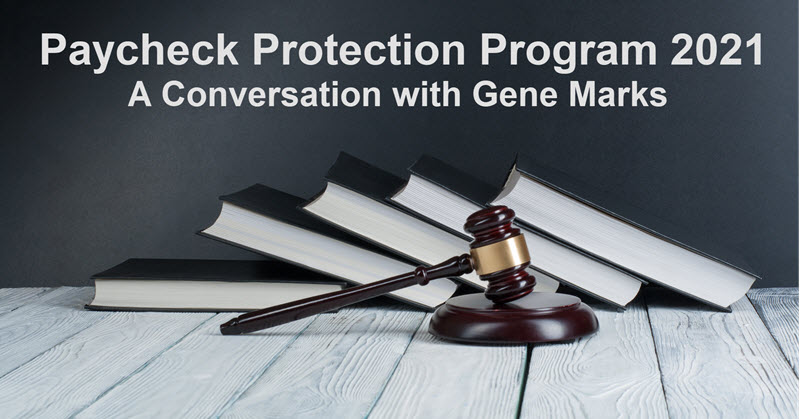The SBA is again accepting and processing applications for PPA loans. Joining us today is Nigel Nabuurs, product manager at Patriot Software Payroll and Accounting, sponsors of our COVID-19 Round Tables.
The COVID-19 Advisor Resource Page on our website contains valuable information for you and your clients in navigating through these difficult waters as well as recordings of previous round tables. And articles about our round tables are being published on the Woodard Report website. There is a five-article series about our January 5 round table with Gene Marks on the Woodard Report website.
Joe Woodard: Some of the resources that are available in the COVID-19 Advisor Resource Page have to do with acute problems like the COVID-19 crisis. Don’t dismiss the resources from April and May as this is evergreen information for advising your clients through financial traumas and operational disruptions. The Round Table conversations from January 2021 will appear in the On Demand Training tab of the COVID-19 Advisor Resource Page.
Nigel, can you discuss the calculated the PPP loan amount for an LLC taxed as a partnership, where the owner takes distributions but does not have a payroll? This is passthrough revenue. I'm particularly interested because I'm an S corporation owner. So some of the revenue that I receive personally flows through a Schedule K-1. I think I'm out anyway with my salary, but still, it's an intriguing topic. So do you have a thought on that?
Nigel Nabuurs: Yes. This is one of the areas that is generally outside of payroll. I'll tell you what I do know about it and what I have read about it. For LLCs taxed as partnerships, really anybody that gets a K-1, you can include the pay to those partners and owners as payroll costs. That’s a new change; originally there was some confusion about this. What you actually do is take the amount from their K-1, which is limited to the $100,000 cap, like all employee compensation. If you or your client didn’t do this on your original loan, you can do so now. You’ll have to talk to your lender, who can reprocess it can get you the diffference. So you can get that additional money.
Joe Woodard: So there's still a reserve from that first round funding sitting out there. If you didn’t exceed that $100,000 cap during the first round of PPP lending, you can include the difference in your passthrough income now.
What about the employee retention credit? Can you break it down for us?
Nigel Nabuurs: The employee retention credit was introduced with the CARES Act back in March. It allows employers a credit for the wages that they paid to their employees if they met certain revenue reduction requirements. For 2020, the revenue reduction requirement was 50%. If you had a revenue reduction of 50% or more in any quarter of 2020 compared to the same quarter in 2019, you could apply the employee retention credit to most of your employees with certain exceptions. You can use it for family members and people that were directly related to the owner. Otherwise, you can get a 50% credit for up to $10,000 in qualified wages for the year. So for each employee, you get $5,000 worth of refundable credits on your 941.
The Economic Aid Act, signed on December 27, made some changes to the PPP. Originally, it was available from mid-March to December 31, 2020. The new law extended the PPP to the end of the second quarter of 2021. So until the end of June, and for the 2021 periods, that $10,000 per year cap on qualified wages has been changed to $10,000 per quarter per employee. That’s a big difference.
For the 2021 quarters, there’s a limit of $20,000 in qualified wages per employee and a 70% credit. If you pay somebody $10,000 in that quarter in qualified wages, then you would get a $7,000 credit.
Those are the minor changes. The biggest change is that originally, if you had a PPP loan at all, you could not take the employee retention credit. Now, if you have a PPP loan, but otherwise would have qualified for the employee retention credit, then you can still use the employee retention credit for payroll costs that weren’t covered by the PPP. That’s retroactive to 2020.
Joe Woodard: Thank you. Nigel. The next question isn’t specifically payroll-related but involves the answer Gene Marks gave us at our last round table. What if a business didn’t operate throughout 2020? Gene told us that if a business operated only in the fourth quarter of last year, they can compare any of the quarters of 2020 to the fourth quarter of 2019. If any one of them was lower than the fourth quarter of 2019, that business can take the credit.
Gene said that if the company was inactive in the first three quarters of 2019 and began operating in the fourth quarter of 2019, then you have to use quarter-to-quarter comparisons. So obviously the first three quarters of 2020 will be greater than quarters one, two and three of 2019 because you can't get less than zero in terms of revenue quarters. You would have to compare the fourth quarter of 2019 to the fourth quarter of 2020. Given a year of growth, you’re probably not going to have a reduction in revenue, even with the COVID crisis, if you were just resuming operations.
Here’s another question: What if you didn't operate for the whole fourth quarter of 2019? If your client bought a company in December of 2019 and it wants to know how it can compare any given quarter of 2020 back to that. I think the implication is that all four quarters of 2020 are greater than the fourth quarter of 2019, but that’s only because in each quarter, your client has three months of revenue versus one.
Nigel Nabuurs: I don't have an answer on that. I don't believe they included that in the news, just as another thing to point out last Wednesday. The Treasury released TFRs that do a really great job covering a lot of questions, such as the first round of PPP and then the second draw. I don't believe they address that specifically.
Click here to continue to Part 2
.png?width=150&height=63&name=TWRlogo-regmark_blueblack%20(1).png)
.png)










Do you have questions about this article? Email us and let us know > info@woodard.com
Comments: